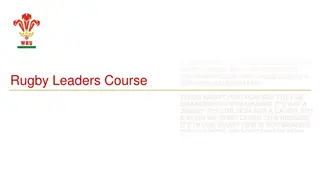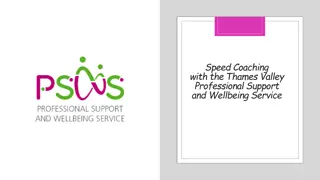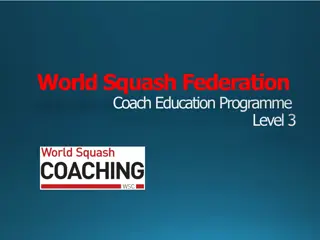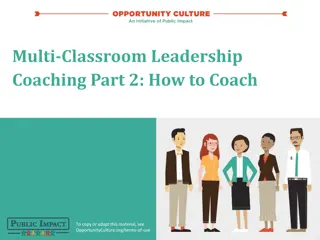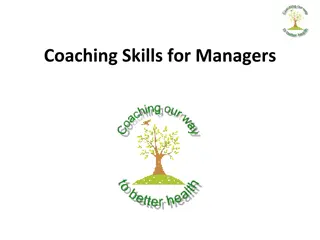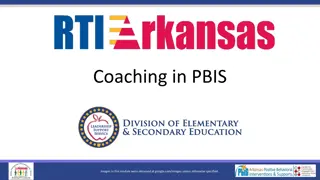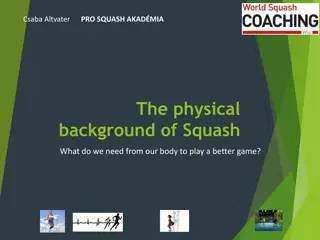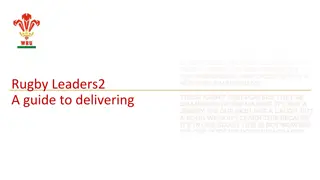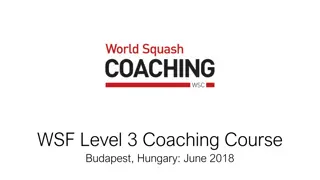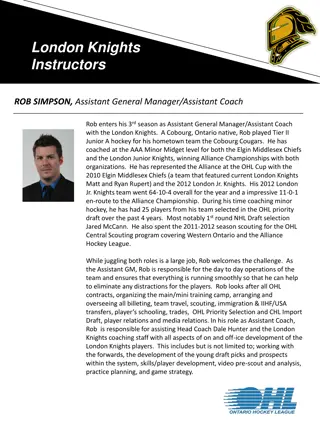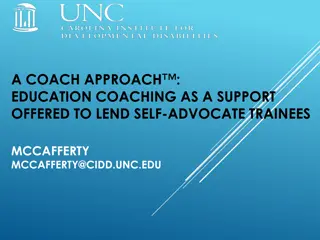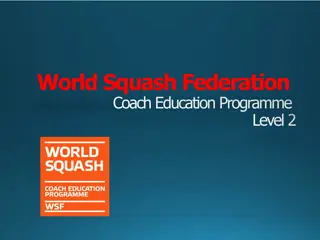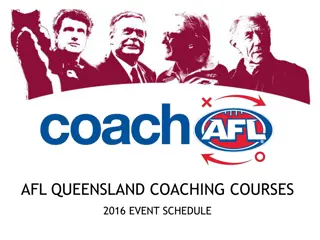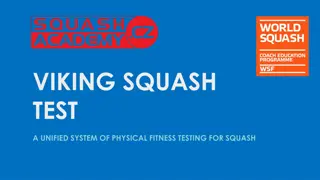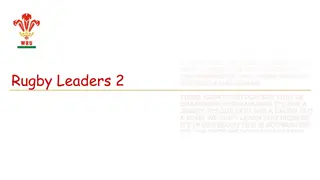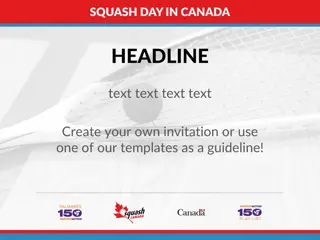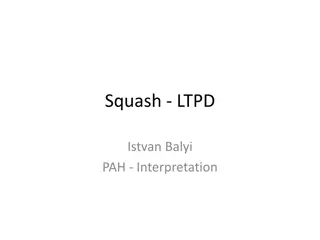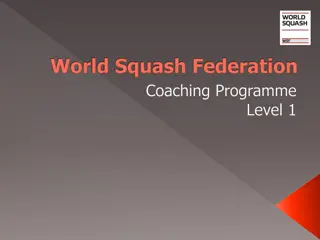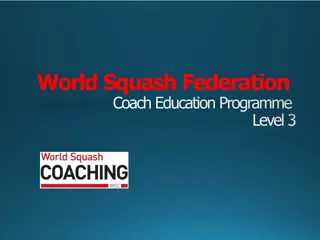Enhancing Coaching Standards in Squash with the WSF Coach Education Programme
The World Squash Federation's Coach Education Programme, particularly Level 2, aims to elevate coaching standards worldwide by ensuring safety, promoting 'World best Practice,' and quality assurance. This program is a significant initiative to enhance the quality of squash coaching globally.
Download Presentation

Please find below an Image/Link to download the presentation.
The content on the website is provided AS IS for your information and personal use only. It may not be sold, licensed, or shared on other websites without obtaining consent from the author. Download presentation by click this link. If you encounter any issues during the download, it is possible that the publisher has removed the file from their server.
E N D
Presentation Transcript
World Squash Federation Coach Education Programme Level 2
Why a WSF Coach Education Programme? WSF Initiative to improve the quality of coaching squash across the World To set an agreed standard that is safe and of World best Practice Coaching that is quality assured Brought together with Collective Knowledge & Collective Experience With a clear emphasis on a process of How to Coach
Philosophy How Squash is judged Open skill = Perception Decision Action (PDA) Process LTPD Biological windows Neurological pathways Based on Knowledge of how squash is played Skill of Delivery of passing information Lesson Planning = Process & use of coaching TOOLS of HOW to coach
Contd The BIG mistake is to just look at the what when it is the HOW that moves theory into practice It is a PROCESS!! Order Thoughts be Explicit To know and not to do is to NOT KNOW! If you have 15 years experience Please use it Do NOT repeat 1 years experience 15 times! Evolution not Revolution!
The Guiding Principles 1. Game Based 2. Coach the Intention NOT the Action 3. Sub-Conscious Learning NOT Conscious Learning 4. Sally Sunflower understand individual differences
WSF Level 2Certificate will enable candidates to: Understand the role of a Coach to effect positive development of intermediate players with additional Skill & Accuracy Understand the process of coaching Tools Effectively demonstrate and use the coaching tools skilfully Plan and incrementally deliver a series of lessons to intermediate squash players
Competency 1 Knowledge and Understanding At the end of this module coaches will be able to: Relate to other coaches and tutors on the course Self-reflect as a coach Understand the challenges of a WSF L2 coach within the WSF coaching programme Re-cap WSF L1 syllabus Understand the coaching process of developing skill and accuracy within open rally situations Skill -Theory into Practice Improving the skill of performance
Assessment Criteria The course / assessment takes 4 parts: Pre-course home study: Introduction to the mind and body in action (Reading list) How the body works: Energy systems, testing Mental skills, Motivation, Goal setting, Concentration ,Confidence Principles of training for LTPD 2. Assessment is on-going throughout the delivery of the course with contribution to discussion, Q & A and practical application to activities being taken into consideration.
Contd 3. Formal practical assessment with: A brief written lesson plan on a given topic to deliver in real time between 20 & 30 minutes The safe practical delivery of individual and / or group lesson A question and answer session with the tutor / assessor based on the course syllabus and what has been delivered. 4. Post course assignment to produce and deliver a 4 week training plan N.B.It is expected that on assessment candidates will be suitably dressed, prepared, on time, and having with them any resources they require to coach. The assessment session should be delivered in a real time situation to affect positive change in a player s open rally skill ability whilst being allowed to express their own personality
Understand the challenges of a WSF L2Coach within the WSF Coaching Programme
Skills Are: Sensory - Motor i.e. Frome the sensory organs Sight Sound Touch Physical movement Perceptual Motor Skills Often referred to Open Skill Big muscle groups Which use the whole body e.g. Squash Small e.g. Keyboard skills NBMost gross skills also involve some use of the fine coordination s e.g. Squash
Understand the coaching process of developing Skill and Accuracy within Open Rally situations Theory into Practice Definitions of the different types of skill and guidance through practical examples of how they apply in a learning situation specifically for squash
Open Skill An open skill is To apply a movement which is technically sound for a particular action and which is an integral part but NOT the whole part of the skill e.g. Where the situation is changing requiring the player to Read the opponents actions Make a decision as to what they will do i.e. starting to move towards where they will time the ball Strike the ball accurately to the chosen target
Contd Closed Skill Action / Technique of striking may be described as a closed skill Squash players may be proficient in striking the ball but lack the skill in an open rally because they do not recognise (Perception) the right opportunity to make a good decision and to then use their technique N.B. It is imperative that squash is taught mainly for it as reflected in a match situation
Hicks Law Hick's law - Wikipedia, the free encyclopaedia https://en.wikipedia.org/wiki/Hick's_law Translation of Hick s Law into squash specific example e.g. Player A plays a very tight shot to length with the ball rolling along the wall. This suggests that the options available to player B are severely limited Player A anticipates that player B is very likely to play the ball straight which equals one option Hence player A has more time to choose and execute his next chosen shot If player A plays a very loose ball then player B has unlimited options Hence player A has a lot more information to process the actions of player B. Hence player A has a longer reaction time, taking more time to process Highlight he difference between Anticipation -What is likely to happen & Perception Proof of what has happened??? That playing a game or rally involves all of the actions taken over the whole period of the activity of the game or rally e.g. WWWH = PDA and is described as an open skill That every player will develop their own style as dictated by their nature, coordination, length of levers etc
Factors Affecting Skill Learning Coaching Demonstration Verbal Directions Practice Competition Knowledge of Results Motivation Distribution of practice Speed and accuracy Whole and Part Learning Progressive Skill Building
Coaching Is where the coach guides the learning process and sets practice progressions with specific areas of focus for the learner so enhancing the learning process and improvement e.g. PDA -Grip George Linking action to result Good instruction helps the learner players progress more quickly rather than just performing practice drills without specific areas of focus Advantageous to get this right in the early learning stages Even with good instruction the player must be allowed to have a go and progress with some trial and error As in do not provide any feedback! TOOL: -When problems do less! The player needs to adapt to movements of good form TOOL: 0- ---100 One size does not fit all Use different areas of focus Encourage experimentation to help develop personal style
Demonstration A picture paints a thousand words Practical demonstration is very valuable at all levels providing it is good The player needs to see the demonstration in context of the rally for it to be effective e.g. WWWH = PDA Demonstration should preferably be done at normal speed with little dialogue using the following process B. Ideally all 6 of the following progressions should be applied in the single session
Sequence of Progression In real time with the coach and player circling and driving to length on one wall, the coach introduces the area of focus so the player recognises the situation where there is an opportunity to produce the designated shot The player in an unpressured situation tries the new shot within a Closed Skill routine for a max 2mins. This progresses to: A Show & Test rally where the coach highlights the most relevant visual cues for the player to focus attention on To then test when the player feels that s/he can recognise a good opportunity Progresses to: A cooperative game in an Open Skill format, emphasising accuracy with both coach and player taking the opportunities to play the new shot when appropriate Progresses to: Open Rallies in real time for consolidation practice Include the trained task in a practice match
Verbal Instruction The technique of striking the ball within a skill is relatively simple so the skill becomes the ability to recognise the ongoing situation of reading the opponents actions and making a good decision as to what response (Action) to take e.g. PDA Therefore verbal instructions should focus attention on how to recognise the best options. In deciding what to look for and how best to choose, use PDA Detailed descriptions of striking movements should be avoided or kept to a minimum Example of teaching an infant to walk With an open skill players learn best when they actively perceive, decide and act from the instruction As players progress, verbal instruction can help to add new meaning to the skill. This helps the player to correct his own actions The TOOL: When problems occur Do less applies, which simply means take information away. The less conscious players are of their physical movements the more their natural body rhythms are allowed to take over The tutor introduces a practical example of sprinting as fast as possible while trying to describe what each part of the body is doing at any given time. The same could be done with a walking example
Practice As discussed in the demonstration sequence / process Let them try Modify things to make it work Repetition does not necessarily make it better, often it makes it worse as a poor movement pattern becomes ingrained It takes time to overcome errors and learn more efficient and effective ways N.B. Relates directly to the Progression Sequence
Competition Is to measure oneself against / test / gain superiority over / defeat an opponent One on One direct opposition It is the way that squash is played, competed for, won and lost Hence competition is essential to the skill learning process as it includes all the components required in squash Competition can take 2 forms to gain maximum benefit Practice matches Where no real pressure exists to win or gain ranking points where the aim is to make all of the elements come together Competition matches / Tournaments often with crowds / noise etc, where there is a perceived pressure to win
Knowledge of Results Knowledge of Results is a form of feedback to pupils, specifically referring to the performance of a skill. If players practise without knowing how well they are doing it is very unlikely that they will improve TOOL: WWWH-PDA When players acknowledge their mistakes they can begin to take steps to correct them The key lies with identifying the cause of the mistake TOOLS: Diagnostic Clock & Linking the Action to Result both apply Physical targets can play a big part in providing knowledge of results which allows players to adapt their actions to compensate Add attacking options to press home an advantage and defensive options when under pressure N.B. It is important that knowledge of results are obtained within an open rally situation to gain accurate information as to the cause of mistakes rather than the symptom
Motivation Squash should be pleasurable with some degree of success which is essential to continue in the sport. Therefore the feelings that accompany playing squash are important Pleasure arises when the right actions are taken and frustration occurs when things go wrong Knowledge of the results helps the player to identify skill deficiencies thus aiding the developmental process which in turn provides the motivation to improve It is the quality and focus of the practice that aids learning and motivation Learning methods that provide steady progress prevent bad habits and ensure the correct development of squash skills e.g. PDA
Contd Praise from the coach improves the development of skill but when used too often it loses value Do not criticise too quickly, and be constructive when you do TOOL: when Problems do Less, to avoid frustration Competition is invaluable in building squash skills as it incorporates all the elements of playing squash and therefore it is often a motivational TOOL: However competition can work against motivation when winning becomes too important. Far better to apply process goals in competition i.e. encouraging the reproduction of the skills in a competitive situation with success and praise
Distribution of Practice Developing squash skills is limited by time. The limiting factors for any one session are governed by The interest of the player/s Level of physical and psychological fatigue, manifested in feelings of Tiredness, boredom, increased errors, inattention to the quality needed for the task, lack of focus concentration The practice should stop if and when the player loses interest The maximum duration of a practice is therefore also governed by the level of ability and the motivation of the player Many coaches and players set themselves a training session based purely on time TOOL: 0 -100 For skill development session based on time will not be successful but may have strength and stamina benefits When the skill level begins to drop the session should stop or new elements to stimulate interest and add focus should be introduced
Contd Adults have greater concentration powers and so can maintain the quality for longer periods than children Novices tend to be tense and use excessive energy A strongly motivated player can practice and maintain quality for longer Practicing little and often is considered to be the best option (Distributed Practice) This means that when learning a new skill sessions should occur frequently Skilled players can derive great benefit from mental practice Pressure training can enhance the whole skill by reducing the time for the player to read the situation, process the information to make a decision and to execute PDA Pressure training should stop when the quality cannot be maintained
Speed & Accuracy Tradition has dictated that in order to achieve both speed and accuracy, we start gradually with accuracy, and then work on increasing speed This is based on the assumption that it is easier to speed up accurate movements than to correct fast inaccurate ones Slow movements are performed differently even though the path of the movement is the same Therefore when both speed and accuracy are required the emphasis needs to be on the speed increasing as quickly as possible TOOL: 0 100 applies
Whole & Part Learning Whole and part learning means that coaches first demonstrate the whole movement within a rally situation. Let the player try. Then break it down into a smaller movement ( part of the rally) Practice the small part until consistency is achieved then return to the whole movement of a rally situation as quickly as possible This creates the learning in context of the rally which includes the PDA process rather than just the action of striking a ball
Progressive Skill Building Is where coaches start with the simple process of driving to length with a partner This is one shot and one target Add a drop shot -two shots two targets Add a boast and a cross court drive -four shots three targets Add the opposite side length drive four shots four targets all in context of a rally PDA
Factors which vary with learner players Age Sex Intelligence LTPD PowerPoint Presentation
Some Rules for Skill Building When attention is paid to the Action i.e. the striking movements that are made, are they smooth, rhythmical, and balanced? -TOOL: Relaxed rhythm That good coaching is beneficial when it is well informed and appropriate to the level of the player The player must ultimately play without guidance therefore instruction should be interspersed with longer periods of clearly focused practice without technical help The coach should remain as a focal point for the player when problems arise but eventually the initiative must rest with the player. This is when discovery and self coaching become more valuable In squash it is the ability to recognise the ever changing situations, make good choices and strike with accuracy e.g. PDA which denote a skilled player The coach s role is to facilitate the process and sequence of events (PDA) to allow the player to learn Learning is done by the player Players reserve the right to develop their own individual style! NB Learning has only taken place when the skill can be reproduced in a game!
Competency 2 Skill of Delivery By the end of this module, coaches will be able to demonstrate that they can; Understand the key principles of Introduction Demonstration Pedagogy (Time on task Progressions) Observe and diagnose areas for the development of skill and accuracy Understand the purpose of coaching TOOLS and demonstrate how they enhance the development of skill and accuracy to affect positive change Assess matches from a tactical perspective Understand, introduce and practically apply tactical awareness
Demonstration & Practice in Sequence Demonstration to show the whole rally in real time, highlighting any new shot to be added to the rally one at a time. Player briefly tries the new shot within a closed-skill situation. Progress to a SHOW & TEST rally where the coach, within the rally, highlights the most relevant visual cues. When the player is confident that s/he can see the differences in the visual cues, move on to the TEST with the coach playing randomly within the same limited pattern. This progresses to a cooperation game in an open skill situation, with the emphasis being on both coach and player playing randomly within the limited pattern where emphasis on accuracy is essential. Then progress to same pattern game within an open skill situation in real time at speed for additional practice. TOOL: 0 --------100 Include the trained task in a practice match
Sequence of Progressive Skill Building 1 corner/quarter game Coach & player playing to length 2 corner game By adding a straight drop 3 corner game By adding a boast and cross-court drive to the back of the service box Becomes 4 corner game Becomes 5 & 6 corner game by adding straight drive on the opposite wall with straight and cross court drive Becomes 7 & 8 high overhead by adding high straight and cross court lobs Can be done as one on one or group session.
Example of the Lob What A high, soft, floating shot to the back of the court. Played straight or cross court high on the front wall and onto the side wall Why Defensive to relieve pressure and buy time to recover. Attacking -To buy time and limit opponent s options. To change the pace in a rally When The opponent is in a commanding T position How/Perception Watch your opponent (body position) and their racket head immediately prior to contact to track the ball in order to determine the speed, height and width of that shot How/Decision Choose target/stroke selection and pace of shot How/Action Start from the T-zone, move towards striking zone and begin racket preparation. Allow space between the elbow and body. Last stride on balance adopting a sideways position. Emphasis on lower racket preparation so you can hit underneath the ball, whilst follow- through remains high. Push off leading leg to recover back to the T zone.
Example-2 Wall/Attacking Boast What Usually played with pace to strike the side wall low, then the front wall and to hit the opposite side wall nick on second bounce Why As an attacking shot to reduce your opponent s organisation time When When your opponent is in front and not looking OR when you are on the T-zone with your opponent behind you and you are able to cut the ball off early How From a watching position on the T-zone Recognising that your opponent is not looking OR is behind Cut the ball off as early as possible With a wide foot base and facing the side wall
Example of the Nick Shot What Hit the ball lightly to strike the front wall in the opposite front corner to drop into the side wall nick Why To win the point quickly When player is on the T-zone with opponent behind and the ball is loose in the middle of the court How When the player recognises when the ball is loose enough away from the side wall -Get the racket head slightly on the outside or inside of the ball with a loose grip and light brushing action
Example of the Trickle Boast What To hit the ball to strike the side wall and then the front wall without real pace Why As a point winning shot When When the opponent is off the T-zone and not looking How With recognition of a loose ball, with a striking action similar to an attacking boast but without pace using a loose grip
Example of the Kill Shot What Hit the ball to strike the front wall as close to the side wall as possible, with maximum speed and power so that the 2nd bounce is before the service box Why To win the point quickly When When the opponent is away from the T-zone How When the player recognises a ball is high and loose enough, and chooses to take the opportunity, striking the ball with a forward and downward cutting action using a relaxed rhythm
Some More Rules for Progression Progress both up and down: TOOL: 0 to 100 . If success rate is in the range of 1 to 30, the task is too difficult, 90 to 100, too easy Set challenges; to simply set a practice routine is not enough It is the quality of the drill/routine that affects positive change Must have a Focus A routine without purpose can be detrimental Should the player be performing the routine badly, development will be inhibited as the fault becomes part of the muscle memory
Time on Task When concentration levels fall it is time to stop or change the theme being practiced TOOL: 0 to 100 , work at a success rate of between 40 & 80 for learning to be taking place Always aiming to get it better with a clear area of focus
Observe and diagnose areas for development of skill and accuracy What are you looking at and for? What information do you need? In what situation can you judge most accurately?
Diagnosis Diagnosis; this is best done in the game situation as it reflects the real environment of competition The PDA cycle as diagnostice clock
Some Rules for the Diagnostic Clock Identify the causes of the problems, NOT the symptoms, in the order of the PDA cycle, starting at 12.00, the player being ready at the T-zone. The coach observes and works around the PDA cycle to Anticipation , with ticks for what appears to be at an acceptable standard, and crosses for what needs attention. Areas with crosses next to them are areas requiring attention/correction The cause, not the symptom, should be addressed, in the order of the PDA diagnostic clock. The correction programme should be reflected in the three environments of:
Solving the Problems Some Rules The coaching sessions, is where the coaches pass information The players own practice sessions and in the players competition / practice match programmes Practice matches are integral to a player s learning; they are different to competition matches in that they do not have the pressure to win. Coaching Practice Competition are essential to overall learning process. If the player is unable to reproduce the skills in a match situation, then learning has not taken place! All the elements have to come together. Re-assess frequently
Definitions of some Tools WWWH PDA The thinking process Spider Web Grip Radar George Linking action to results Choosing targets Relaxed ryhthm 0-100 Problems do less Show and test




